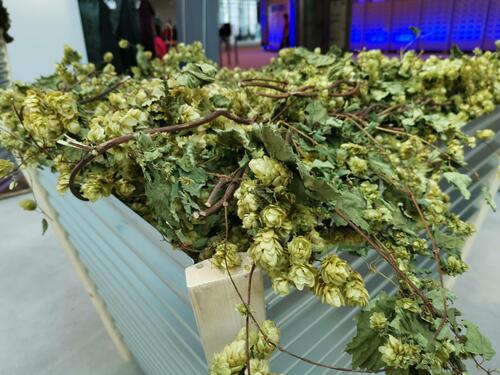Right now, there is a trough of Herefordshire cassis in the middle of the European Parliament. Unless a few MEPs got to it on the late shift.
There's also mud, cowhides, cider apples and a host of articles meant to arrest the senses of passing Brussels beaurocrats and entice them in to the showcase - and in to conversations about Herefordshire, and where it's heading.
The installation has been built and curated by staff and students at Hereford College of Arts, and sourced from the pride of the county's producers.
Here's a little info on what's there, in case you're not able to be.
Follow @herefordshireshowcase and @herefordarts to see what's going happening in Brussels over the next few days.
Cassis - Blackcurrants: Jo Hilditch at Whittern Estate
Herefordshire has a long history of growing blackcurrants, the climate and rolling hills here seem to suit the crop.
Like most fruits, blackcurrants contain a lot of water, but they are also bursting with a wide variety of important antioxidants, fibre and energy.
They may be small, but blackcurrants are one of the richest natural sources of important antioxidants like anthocyanins and Vitamin C. Blackcurrants have more than three times the vitamin C of oranges and anthocyanin levels.
These anthocyanins can help fight against cardiovascular disease, ageing, joint inflammation, eyestrain, urinary infections, kidney stones and even cancer.
As well as high levels of Vitamin C and other antioxidants, blackcurrants contain soluble and insoluble fibre as well as important carbohydrates to give you energy.
Blackcurrants also contain fructose and glucose to give you energy.
Nestled in the rolling hills of verdant North Herefordshire, the Whittern Estate is an historic farm with a passion for contemporary decadence. Once a mixed arable farm, the family chose to take the road less travelled: cultivating blackcurrants, a quintessential flavour of the British countryside
The current guardian of the farm is Jo Hilditch, a bold supporter of the British Blackcurrant industry and of Herefordshire’s rich food producing community.

Apples: Albert Johnson, Little Pomona
In a tradition that dates back more than 700 years, Herefordshire is one of the biggest cider making regions in the world.
The cider orchards in Herefordshire are said to produce over half of the cider consumed in the UK.
Today commercial cider is readily available in pubs, inns and from supermarkets. However, there has been a revival in the popularity of traditional ciders in recent years and now many pubs will offer three or four traditional ciders as well as the usual ciders, in much the same way as they will offer real ales alongside keg beer.
Herefordshire is still known as one of the best cider-producing areas in the world and in spring orchards full of blossoming apple trees continue to make this one of the most beautiful counties.
Herefordshire Cider route
The Herefordshire Cider Route is a circular driving route around the county of Herefordshire visiting cider producers and specialist retailers. An excellent starting point for the Cider Route is the Cider Museum in Hereford, where you will discover the history and development of cider production.
You can pick up more details on the Cider Route from the Museum, where you can see cider being made, taste it and purchase it.
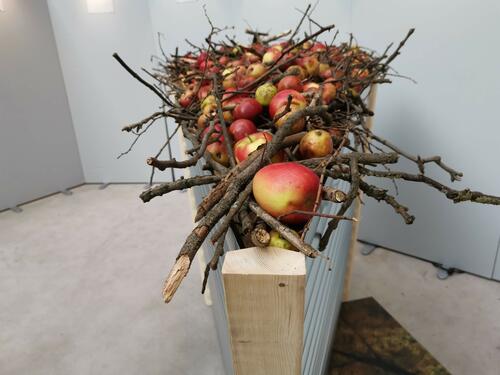
Sessile Oak: Whitney Saw Mill
The oak is held in high regard across most cultures in Europe. It was sacred to many gods including Zeus (Greek), Jupiter (Roman) and Dagda (Celtic). Each of these gods ruled over thunder and lightning, and oak trees are prone to lightning strikes as they are often the tallest living feature in the landscape.
In England the oak has, for centuries, been a national symbol of strength and survival. It has played an important part in our culture - couples were wed under ancient oaks in Oliver Cromwell’s time, the festive Yule Log was traditionally cut from oak, it features on the 1987 pound coin and is the inspiration for the emblem of many environmentally focused organisations, including The Woodland Trust.
The new Globe Theatre, London is made from Oak (from the Forest of Dean), using traditional techniques. The greyish bark of the Sessile Oak has also been used in the tanning industry to produce leather.
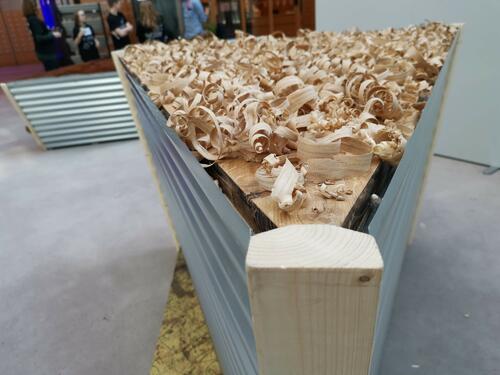
Hereford Cow Hide: Hayley Hanson
The Hereford is a British breed of beef cattle that originated in the county of Herefordshire, in the West Midlands of England. It has been exported to many countries, and there are more than five million purebred Hereford cattle in over fifty nations worldwide.
The Hereford cattle export trade began from United Kingdom in 1817, starting in Kentucky, United States, spreading across the United States and Canada through Mexico to the great beef-raising countries of South America. Today, Hereford cattle dominate the world scene from Australasia to the Russian steppes. They can be found in Israel, Japan and throughout continental Europe and Scandinavia, in the temperate parts of Australia, Canada, the United States, Kazakhstan and Russia, in the centre and east of Argentina, in Uruguay, in Chile and New Zealand, where they make up the largest proportion of registered cattle They are found all around Brazil and they are also found in some Southern African countries (mainly in South Africa, Zambia and Zimbabwe). They originally found great popularity among ranchers of the American Southwest, testament to the hardiness of the breed; while originating in cool, moist Britain, they have proven to thrive in much harsher climates on nearly every continent.
Hayley of Hayley Hanson is a farmer’s wife with a passion for cattle matched only by her enthusiasm for traditional hide tanning. She is the only female tanner left in Britain to carry out the entire lengthy process herself in her micro tannery in Herefordshire. Hayley tans hides from the family herd of British Blue and cross bred Hereford and Angus cows at Eastisland as well as cow skins from local farms and those sent to her from across the UK. She sends finished hides across the world to Texas, New Zealand and Australia. Tanning isn’t for the faint hearted. It’s a dirty, physically demanding job, and can take anywhere between a month and six months depending on the thickness of the hide. When it’s ready it is cleaned, dried and finished.
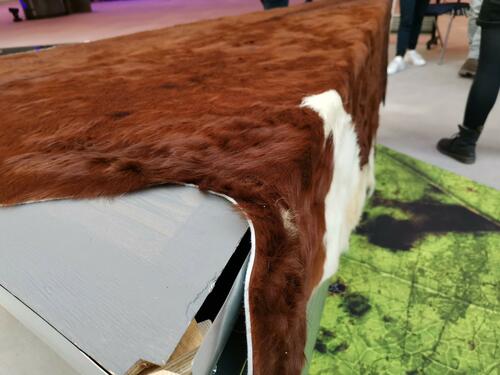
Herefordshire Soil: Herefordshire (south west of the county)
The fine red soils which give the County much of its landscape character and natural beauty, are freely draining slightly acid loamy soils.
These soils have moderate to high fertility and are best suited to orchards, autumn-sown crops and grassland.
These soils have supported famous horticultural nurseries over the last 200 years. Free drainage reduces the risk of soil damage from grazing animals or farm machinery.
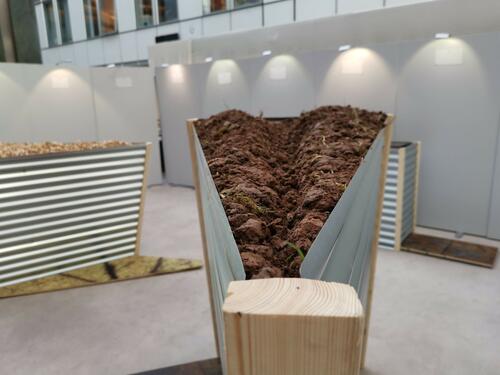
Ryelands Wool: Sheep Shed in Leominster
Ryeland sheep are a traditional British sheep breed going back seven centuries and originating in Herefordshire, when the Monks of Leominster bred sheep and grazed them on the rye pastures. British Ryeland sheep come in coloured varieties from grey, black, brown and white. They produce high quality wool - hand spinners and weavers seek out Ryeland Wool for its texture and quality.
During the 16th Century the breed increased in popularity – Queen Elizabeth I was a strong supporter of Ryeland Wool after receiving a pair of stockings as a gift from the wool. The wool then became the measure of quality that other wools were assessed against.
Ryeland sheep grow an exceptionally fine, soft and fluffy fleece. ‘The Sheep Shed’ in Leominster have contributed fleece to exhibitions by our BA (Hons) Textile Design course.
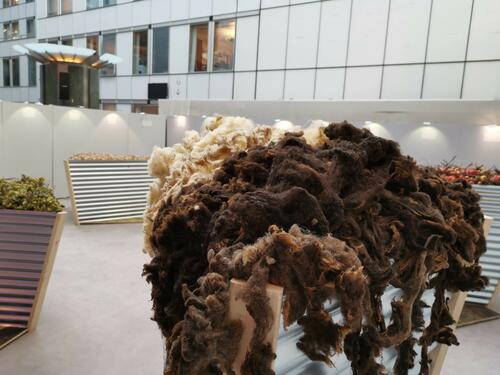
Hops: Charles Faram
Fields of hops are known in most parts of the country as hop gardens, but in Herefordshire they are called hopyards. Once a hopyard had been established, provided it was kept free from disease and properly cultivated, it would go on producing hops for fifteen years or more before needing to be replanted.
Hop growing in Herefordshire is now mainly concentrated in the sheltered river valleys of the Frome and the Lugg in the west of the country, where there is at least a 45cm depth of loamy soil with a medium to heavy texture. A plentiful supply of water and food is also needed for good growth, as is good soil drainage. At one point or another at least 80% of Herefordshire's parishes have extensively cultivated hops. The first reference to hop growing in the Bromyard district of Herefordshire is in 1577, in the Swithin Butterfields Survey for the Bishop of Hereford.
For at least 300 years Herefordshire produced more hops than the local brewers needed. The poor road network of the county and the lack of canals and railways meant that it could often by quite costly to transport the hops to the parts of the country where there was a market for them. However, the cost was offset by the fact that the crop could be produced more cheaply in Herefordshire than in many other parts of the country.
While you may be familiar with grape vines, hops actually grow on a bine. A bine plant differs from a vine because it uses its shoots instead of its tendrils to climb. Male hop plants do not produce any of the essential oils needed to make beer, so commercial hop farms are made up only of female plants.
